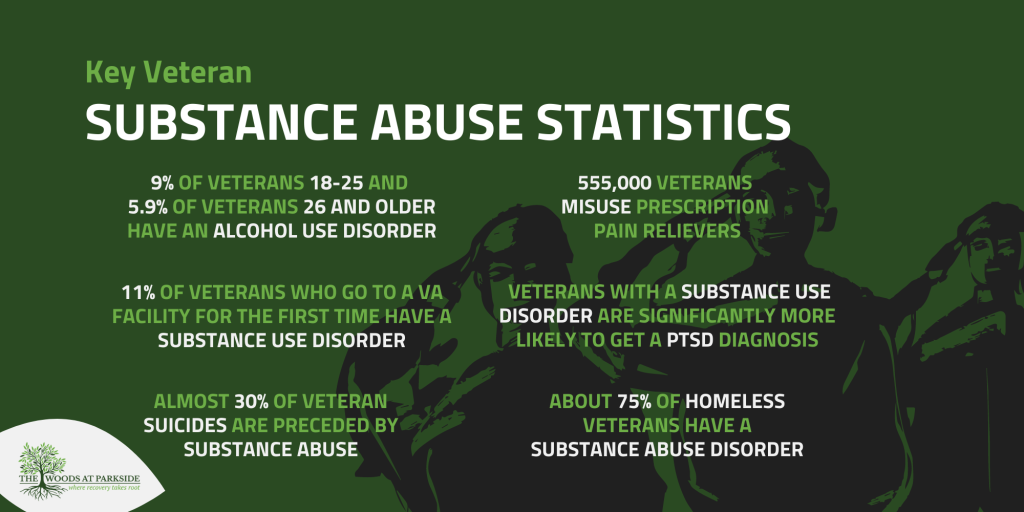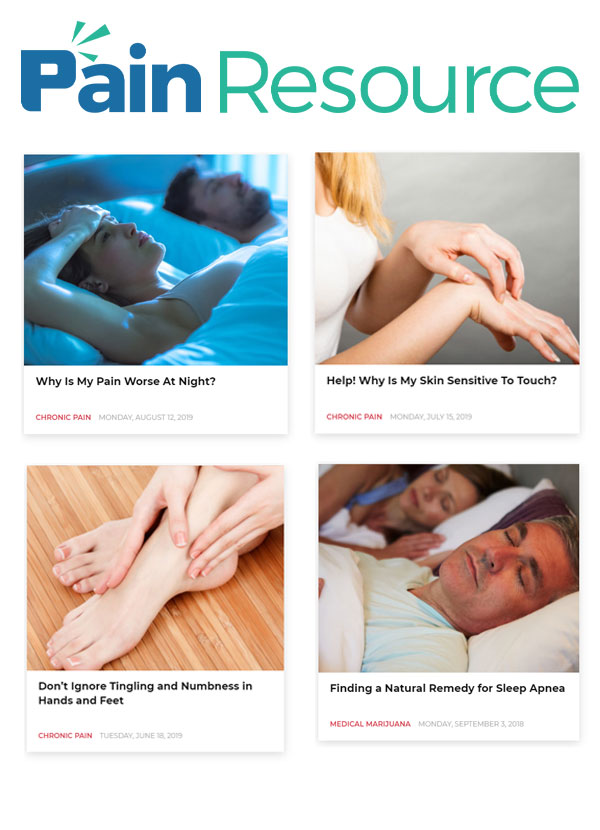
Substance abuse disorders are common in veterans, including issues with alcohol, prescription medications, illegal drugs, and more. Here’s a rundown on statistics about veteran substance abuse and how to find veteran substance abuse treatment in Ohio.
Are you looking for the best veteran substance abuse treatment in Ohio? Contact us today at The Woods at Parkside to begin the optimal treatment for you.
Veteran Substance Abuse Statistics

Statistics can help you understand the challenges veterans face in living with substance use disorders. If you are a veteran, you may realize that you are truly not alone in your struggles. What’s more, if a loved one is a veteran trying to stop drug or alcohol abuse, you may gain insight into why they could use help for veterans with substance abuse.
Lives of Ohio Veterans
Being a veteran in a world that does not always offer you help and support is hard enough. Yet, even more devastating are the effects of substance abuse on a veteran’s life.
From Veterans Data Central, the following Ohio veteran substance abuse statistics will help you understand some of the difficulties Ohio veterans face.
- 709,287 veterans live in Ohio.
- 7.2% of the veteran population in Ohio live below the poverty line.
- The unemployment rate for veterans is 4.1%, which is significantly lower than the 5.2% unemployment rate for all Ohioans.
- 127,366 Ohio veterans have service-connected disabilities.
- About 730 veterans in Ohio are homeless, many with addictions or mental health issues.
Although you or your loved one might not be disabled, homeless, or living in poverty, these statistics are a reminder of what can happen, especially when substance abuse is a factor.
Veterans and Substance Abuse

A SAMHSA report on alcohol and illicit drug use in Ohio provided some insight into the depth of the substance abuse problems in this state. Researchers asked if participants in the study had had the following experiences in the past month or year and tabulated their answers.
- 7.7% of Ohioans over the age of 12 used illicit drugs in the past month.
- 24.48% of Ohioans over 12 years engaged in binge drinking in the past month.
- 39.53% perceived a risk of drinking five or more alcohol drinks once or twice every week in the past month.
- 8.93% of Ohioans were dependent on or abused drugs or alcohol in the last year.
- 6.88% of people in Ohio needed but did not get treatment for alcohol use in the past year.
- 2.52% of Ohio residents need but did not get treatment for illicit drug use in the past year.
- 5.5% of Ohioans had used pain relievers for nonmedical purposes in the last year.
While the substance abuse issue is significant in Ohio’s general population, SUDs are even more prevalent among veterans. Help for veterans with substance abuse is always needed. The following veteran substance abuse statistics from the 2019 National Survey on Drug Use and Health show the extent of this problem in the United States.
- 9.9% of veterans 18-25 and 5.9% of veterans 26 and older had alcohol use disorder.
- 555,000 veterans misused prescription pain relievers.
- 10.1% of veterans aged 18-25 and 2.8% of veterans aged 26 and older misused opioids.
- 3.2% of veterans aged 18-25 and 0.5% of veterans 26 and older had cannabis use disorder.
- 3.4% of veterans 18-25 and 0.6% of veterans 26 and over used cocaine.
- 2.5% of veterans 18-25 and 0.5% of veterans over 25 used methamphetamines.
American Addiction Centers also provides veteran substance abuse statistics, including stats on both substance abuse in general and alcohol specifically. In addition, the numbers show how veterans are affected by PTSD. This is important because veteran PTSD and substance abuse often go hand in hand since it is a condition people often self-medicate for with drugs and alcohol.
- 11% of veterans who go to a VA facility for the first time have a SUD.
- Among veterans with SUDs:
- Over 80% engage in alcohol abuse.
- About 27% engage in illicit drug abuse.
- About 7% engage in both alcohol abuse and illicit drug abuse.
- About 25% of veterans suffer from PTSD.
- Veterans with a SUD are significantly more likely to get a diagnosis of PTSD.
- Almost 30% of veteran suicides are preceded by substance abuse.
- About 75% of homeless veterans have a substance abuse disorder.
- The risk of a female veteran developing PTSD is twice what it is for male veterans.
The statistics overall paint a somewhat alarming picture of substance abuse. Yet, for veterans, substance abuse is often related to a myriad of other difficulties. Veterans tend to face challenges that most civilians never have to consider. Whether healing from the trauma of being in a combat zone or assimilating back into the civilian world after service, veterans with substance use disorders need not only enough help but help designed specifically for their needs.
Seeking Veteran Substance Abuse Treatment
Seeking veteran substance abuse treatment can seem overwhelming. Once you understand why it is so hard, when to look for help, and what treatments are available, you may feel much better about reaching out for professional substance abuse care.
When Is It Time to Get Professional Help?
Anytime you see that substance abuse is interfering with your life, it is a good time to seek help for veterans with substance abuse. Watch for signs that substance use is playing too large a role in your life, disrupting your relationships, or taking up too much of your time and resources. Remember: if substance abuse is already damaging your life, seeking help now is the best way to prevent matters from getting worse.
Getting Past the Hurdles
There are many reasons why people hesitate to seek help for veterans with substance abuse. They may be worried about family issues, such as child custody, getting childcare, or partners who do not understand. Many veteran substance abuse treatment programs can help you deal with family issues through family therapy and other services.
Some people worry that treatment will make it harder to get or keep a job. What you need to remember is that once treatment is successful, you will be a much better employee than you could be while abusing drugs or alcohol.
Veterans have shown through their willingness to serve that they are among the strongest people around. Yet, they often worry that seeking help will make them look weak, either to others or to themselves. Yet, the strongest thing you can do is to take charge of your life by overcoming substance abuse alongside experts who can help you get the best results.
Types of Treatment Programs Available
It’s crucial to know that there are different levels and types of help for veterans with substance abuse. Therefore, even if you are not sure your problem is serious enough to warrant full-blown treatment, you can still get help at the level you need. Talking to a substance abuse specialist is the best way to find out what that level is. The following are the main types of veteran substance abuse treatment programs available at The Woods at Parkside.
Detox
This is the initial phase of substance abuse treatment if you need assistance getting past the physical withdrawals of drugs or alcohol. It is a safe place where you will get medical care from doctors and nurses dedicated to protecting your physical and mental well-being. Detox is usually completed in ten days or fewer.
Residential Treatment
Residential treatment is a longer-term substance abuse treatment program that offers help for veterans with substance abuse using the 12-step program, counseling, and a variety of other groups and therapies. The program is designed to last 45 days. The Woods at Parkside also offers a residential dual diagnosis program, which helps people who have both substance abuse and other mental health issues. This program is often recommended for veterans PTSD and substance abuse.
Partial Hospitalization
At partial hospitalization, you go to treatment at The Woods at Parkside for eight hours a day and go home in the evening. This gives you an in-depth program that also allows you to work on resolving issues at home.
Intensive Outpatient Program
Intensive outpatient programs last three hours, three times a week, for continuing care.
What Happens in Treatment?
An excellent veteran substance abuse treatment program incorporates a variety of medical interventions and therapeutic activities. Some of the things you will engage in during treatment might be:
- Individual and group therapy
- Music therapy
- Recreational therapy
- Life skills classes
- 12-step groups
The main thing that happens when you seek help for veterans with substance abuse is that you discover tools to help you deal with your personal, mental health, and substance abuse issues. You can go beyond the veteran substance abuse statistics. Then, you can overcome your addictions and build a satisfying and rewarding life.
Would you like to put substance abuse in the past? Call The Woods at Parkside to learn about our veteran substance abuse treatment options.
The post A Guide to Seeking Substance Abuse Treatment for Veterans in Ohio appeared first on The Woods At Parkside.
Source
Original Author: Beacon User

